I’ve been meaning to blog for a while, but teaching is such an odd profession. While most people assume things gradually ‘wind down’ at the end of the year, they instead actually ramp-up, before coming to an abrupt end. The last week of our school year was filled with the usual madness of moving classrooms, finishing report cards, saying goodbye to beloved staff members, and … something different: our virtual digital museum.
“Hi, welcome to our virtual digital museum. We have been learning about First Nations people and European Explorers.”. A student hands a visitor an iPad. “You can use the app “Scan” to explore the different displays”. He confidently points to the red app with the white borders. “This is a QR Code Scanner, use it to access the different videos that will tell you about the artifacts on display.” One by one visitors enter the museum. The student hosts support, answer questions, and inevitably serve as ‘tech-support’ and ‘security’ making sure that none of the artifacts are manhandled. Students, teachers, parents, administrators tour the museum, scanning the codes and watching the videos. A buzz of excitement fills the room.
It wasn’t that long ago when I sat with Melissa Murray (@MelissaMurrayYR) and she explained that the new Social Studies History/Geography Curriculum was about ‘doing the work of a historian’ , or ‘doing the work of a geographer’. What does that mean? What does it look like? What do historians and geographers do? How do they generate knowledge and understanding of the world, and the world that came before?
Taking a Step Back In Time:
In order to strengthen my student’s understanding of the impact of the contact between First Nations People and European Explorers, I wanted my students to act like historians. What do historians do? They discover artifacts/evidence of people from the past, and work to determine the story behind them. As ‘historians’, my students would work to create a museum of artifacts showing the different aspects of this period of history. The ‘artifacts’ they explored could be as simple as a bowl of salt, or a basket of beads or as complex as a mask, treaty, or map. The Concepts of the Disciplines of Thinking served as the framework for the students to build their inquiries around. They were to explore the Perspectives (Whose stories can we find out?), Significance (Why was this important?), or the Interrelationship (How did the environment affect the way they lived, or how did the way they lived affect the environment?).
… and they were off! I love this part. The stage where I feel inadequate and overwhelmed, and yet empowered and excited. You can read about that stage of our inquiry here. Kids starting to ask questions to which I have no idea of the answer. Students exploring and questioning, students sharing and collaborating. Inquiry in motion! Searching websites, analyzing pictures, reading books, examining maps, and more. Doing the work of a historian! Uncovering evidence of the past and making sense of it!
But, how could they truly share their understanding? Reports? Blah! Who wants to go to a museum and read pages and pages of reports? Would you? Do you actually read the plaques posted beside the artifacts when you explore a museum? How long is your attention span? Two minutes, maybe? 65 seconds? How long can an artifact sustain your attention before you want to move onto the next? What about videos? Can you watch a 60 second video and remain engaged?
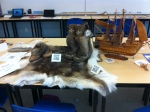
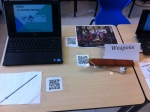
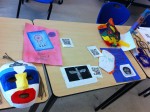 The students used iMovie to create video evidence of the information they had found. Each video focused on one of the Disciplines of Thinking (Perspective, Significance or Interrelationships). Creativity blossomed! Images, maps, voice-overs, music, text… amazing stuff! Once the videos were finished, sharing was easy! I uploaded all of the students videos to my private YouTube account, and linked each video with a QR Code.
The students used iMovie to create video evidence of the information they had found. Each video focused on one of the Disciplines of Thinking (Perspective, Significance or Interrelationships). Creativity blossomed! Images, maps, voice-overs, music, text… amazing stuff! Once the videos were finished, sharing was easy! I uploaded all of the students videos to my private YouTube account, and linked each video with a QR Code.
The result was a scannable interactive virtual museum. As the visitors explored the various artifacts, they were able to access the kid-created-content through QR Codes. The part my students like the most, was the final QR Code that linked to a GoogleForm. Visitors provided immediate feedback to the learners by completing a quick survey before leaving.
Wouldn’t it be cool to be able to interact with the curators of a real museum in this way? Imagine being able to explore, interact and respond to the ‘historians’ who curated the displays. After all, aren’t we all historians, making sense of the world around us?
So, thanks Melissa Murray for pointing me on the path of “doing the work of a historian”… because history certainly came alive in our school!

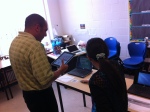
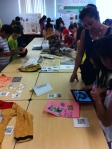
Lisa–in every sense of the word–THIS is education! To be inspired, to be challenged, to be motivated to discover and uncover, and to analyze what is found through multiple lenses–this is to learn! The students in your class were blessed to have you for a teacher–and what they learned with you they will never forget.